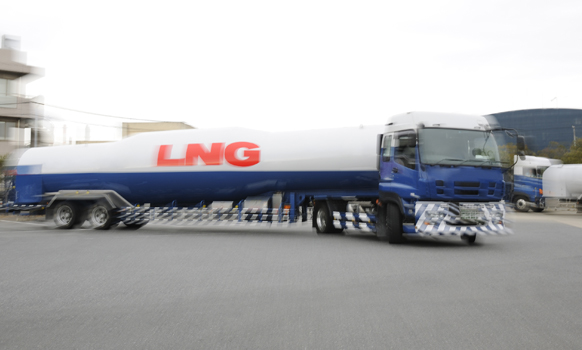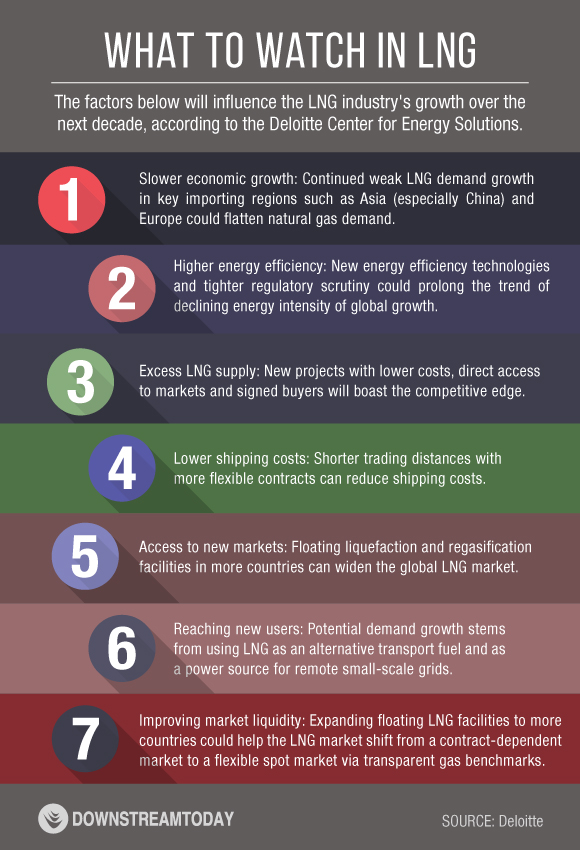What Will Drive LNG Growth for the Next Decade?

Question: What will be more localized, more widely dispersed and more transparent a decade from now? Answer: The liquefied natural gas (LNG) industry.
A recent Deloitte report on the changing LNG landscape presents such a scenario, and one of the report's authors credits the United States' emergence as a gas exporter as a catalyst for the evolution.
"The beginning of exports of LNG from the U.S. in 2016 adds an interesting new component to the global market, expanding the range of options available to buyers both geographically and in terms of pricing basis," said Andrew Slaughter, executive director of the Deloitte Center for Energy Solutions.
Slaughter, who wrote the report with colleague John England, also sees liquid hub-based pricing becoming a more viable option compared to longstanding oil-linked LNG pricing formulas.
"It will be interesting to see whether this type of competition results in changes in strategy from the more traditional LNG suppliers," Slaughter said.
In a recent interview with DownstreamToday, Slaughter elaborated on the Deloitte report's findings. Moreover, he explained why – despite the unease felt by many in the LNG sector – he sees reason for industry players to be optimistic. Read on for his insights.
DownstreamToday: How would you summarize the current upheaval in the global energy market, and where does LNG fit in amid this dynamic environment?
Andrew Slaughter: In the short term, the global energy market is still adjusting to a lower oil price environment, in which crude oil prices dropped from above $100 per barrel down to $30-$40 levels since June 2014. While the primary causes of this were an accumulating imbalance of oil supply growth, relative to oil demand growth, the LNG market was not immune to the consequences. Long-term contract prices for LNG, which are linked by formula to crude oil price levels, have declined along with crude oil, negatively impacting the cash flow of existing LNG suppliers, as well as putting into question the expected economic returns for new and proposed LNG supply projects.
Over the longer term, in a world where most nations have committed to carbon mitigation policies at COP21, we expect natural gas to be able to increase its share of energy demand around the world, both because of its intrinsically lower carbon intensity than other fossil fuels and also because of its complementarity with renewable energy in the power sector, providing grid stability and reliability when renewable generation is not available. We expect LNG to play a significant part in meeting this growth in gas demand around the world over the next two or three decades.
DownstreamToday: Deloitte has observed that the LNG trade has quadrupled over the last two decades and is poised to double over the next two decades. What were some key attributes of the previous growth period, and what major characteristics would you expect during the next one? Any particularly prominent similarities/differences?
Slaughter: LNG market growth over the past 20 years has predominantly been characterized by the development of large integrated gas projects in which most LNG has been committed to buyers under long-term contracts. This model has been necessary to secure project financing for multi-billion dollar investment in upstream gas development, liquefaction trains, specialized ships and regasification terminals. Using this model, new LNG supply sources have been developed in resource-rich countries like Qatar, Australia, Trinidad and Nigeria; and large new markets have been opened up, such as India and China.
Over the next 10 to 20 years, we expect growth in the LNG market to be associated with the opening up of many more, often smaller, markets served by more flexible supply options, such as floating storage and regasification units, smaller, more modular liquefaction technologies and the growth of both portfolio supplies and LNG traders to more flexibly match supply with market needs. We also expect new and emerging applications for LNG to grow, creating an additional boost to demand – such as LNG as a marine fuel and as a fuel for heavy trucks and rail.
DownstreamToday: You've identified seven key factors that should drive LNG growth in the next 10 years. Which of these factors is supported by the strongest evidence? Which factors are more of a guessing game?
Slaughter: Of the seven key factors identified in the Deloitte report, three represent challenges for LNG development, at least for the next several years. The potential slowdown in global economic growth, and perhaps particularly in China, may lead to a near-term slowing of LNG demand, as will continued improvements in energy efficiency which work to decouple demand growth rates from economic growth rates. Thirdly, the amount of new LNG supply capacity planned or announced is a threat to sanctioning the next wave of LNG projects which will likely be needed post 2020.
On the side of opportunity, the other four factors are more favorable to LNG development. These are the reduction of LNG shipping costs, allowing markets to be served more economically; the development of new markets geographically, such as in South East Asia and Latin America; the emerging penetration of LNG into new applications such as for road and marine transport fuels, as well as the larger-scale expansion of LNG as a source for natural gas as a power generation fuel; and the expansion of market liquidity, with more buyers, more sellers, more diverse contract terms and durations making it easier for market participants to structure the right deals to expand their business.
There is fairly strong evidence supporting all these factors, and it will be fascinating to watch how they play out over the next 10 years or so.
DownstreamToday: You've no doubt seen industry headlines proclaiming that the era of mega-LNG projects is drawing to a close and that small- and mid-scale projects are on an upward trajectory. What effects on the broader LNG market do you anticipate with the rise of smaller-scale projects?
Slaughter: Smaller-scale projects are emerging on the liquefaction side of the business with project developers proposing smaller and more modular units than have historically been the norm; and also on the regasification side of the business with the increasing deployment of floating regasification and storage units to serve new market locations. Such developments reduce the upfront capital required to launch an LNG project, potentially opening up new sources of financing. And these developments add more flexibility and optionality to the market, and will contribute to the development of new markets and the growth of portfolio players and traders who can play a role in enhancing the efficiency of the market.
DownstreamToday: What is the most surprising thing you learned while preparing your report?
Slaughter: Despite higher-than-accustomed levels of uncertainty about LNG prices, growth prospects and the viability of new supply investments, market participants maintain a high degree of long-term optimism about the future of LNG as a growing and strategic part of the world's energy supply and trade. This is founded on the attractiveness of natural gas as a fuel in major and emerging markets, for which its lower carbon intensity than other fossil fuels plays a major role; and on the maturing of LNG market structures globally, to accommodate new buyers, new sellers and new contractual options.

Source: Deloitte
- How Likely Is an All-Out War in the Middle East Involving the USA?
- Rooftop Solar Now 4th Largest Source of Electricity in Australia
- US Confirms Reimposition of Oil Sanctions against Venezuela
- Analyst Says USA Influence on Middle East Seems to be Fading
- EU, Industry Players Ink Charter to Meet Solar Energy Targets
- Russian Ships to Remain Banned from US Ports
- Brazil Court Reinstates Petrobras Chair to Divided Board
- EIB Lends $425.7 Million for Thuringia's Grid Upgrades
- Var Energi Confirms Oil Discovery in Ringhorne
- Seatrium, Shell Strengthen Floating Production Systems Collaboration
- An Already Bad Situation in the Red Sea Just Got Worse
- What's Next for Oil? Analysts Weigh In After Iran's Attack
- USA Regional Banks Dramatically Step Up Loans to Oil and Gas
- EIA Raises WTI Oil Price Forecasts
- How Likely Is an All-Out War in the Middle East Involving the USA?
- Venezuela Authorities Arrest Two Senior Energy Officials
- Namibia Expects FID on Potential Major Oil Discovery by Yearend
- Oil Markets Were Already Positioned for Iran Attack
- Is The Iran Nuclear Deal Revival Project Dead?
- Petrobras Chairman Suspended
- Oil and Gas Executives Predict WTI Oil Price
- An Already Bad Situation in the Red Sea Just Got Worse
- New China Climate Chief Says Fossil Fuels Must Keep a Role
- Oil and Gas Execs Reveal Where They See Henry Hub Price Heading
- Equinor Makes Discovery in North Sea
- Macquarie Strategists Warn of Large Oil Price Correction
- DOI Announces Proposal for Second GOM Offshore Wind Auction
- Standard Chartered Reiterates $94 Brent Call
- Chevron, Hess Confident Embattled Merger Will Close Mid-2024
- Analysts Flag 'Remarkable Feature' of 2024 Oil Price Rally






